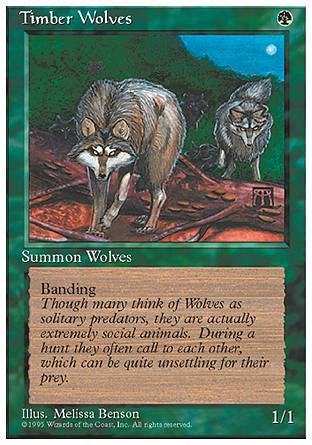Players love their Slivers. Ever since their inception in Tempest, Wizards of the Coast has given us numerous Slivers time and again. With each reintroduction of the creature type, Wizards has reached deeper into the pool of keywords and mechanics for every Sliver [you control] to share. From basic abilities like flying (Winged Sliver) and first strike (Talon Sliver), to powerful effects such as destroying permanents (Necrotic Sliver) and Afflict 2 (Lazotep Sliver). In all, over 100 Slivers have been printed.
There is one keyword ability, however, that Wizards of the Coast never printed on a tournament-legal Sliver card. The ability is so confusing to players that the only way to print a Sliver with this ability was to print it as a test card from the Mystery Booster set.
That creature is Banding Sliver.
What is Banding?
To answer this question precisely, one needs a rulebook and a good deal of patience. While the rules text on Banding Sliver is as simplistic as it gets ("All Slivers have banding"), the reminder text required to explain what this means is a paragraph long.
"Any creatures with banding, and up to one without, can attack in a band. Bands are blocked as a group. If any creatures with banding you control are blocking or being blocked by a creature, you divide that creature's combat damage, not its controller, among any of the creatures it's being blocked by or is blocking."
Say what? Even this bit of text doesn't tell the whole story. Banding behaves differently whether you're attacking or blocking! Any number of attacking creatures with banding can join together with up to one attacking creature without banding. Then if a creature blocks a banded attack, the attacking player chooses how damage from the blocking creatures is assigned--kind of like the reverse of the usual rule.
When blocking, however, the story is slightly different. You can already block a single attacker with many creatures, so you can have many creatures without banding blocking alongside one banding creature. In this case, the defending player may choose how the creature blocked by the creature(s) with banding assigns combat damage.
Are you confused yet? Good, because so am I! The number of questions that arise from this keyword is uncountable. What if I have a flying creature in my band? Can my opponent block with a nonflying creature without Reach? What if one of the banded creatures has First Strike? Double Strike? Trample? How much of the damage is done using these other abilities, and how much isn't?
There are so many rabbit holes to dig down, but the short answer is best explained by the Example on the
"A player attacks with a band consisting of a creature with flying and a creature with swampwalk. The defending player, who controls a Swamp, can block the flying creature if able. If they do, then the creature with swampwalk will also become blocked by the blocking creature(s)."
So, abilities aren't shared because of Banding and if one creature in the band becomes blocked, the entire band is considered blocked.
The rules go on and on, with subsections of 702.22a through 702.22m. If you're looking for a headache, you can read through all the details in the rulebook.
Some Creatures with Banding
As you can imagine, Wizards of the Coast stopped printing cards with Banding a long time ago. I'm not just talking about premier sets, either. You're not likely to see Banding in any Masters, Commander, or Modern Horizons sets either. Banding is a 10 on the Storm Scale, meaning it would require a major miracle for this keyword to return to a Standard set.
I think it's pretty clear why.
This is the section where I highlight the most noteworthy and impactful cards with Banding. With less than 50 such cards, the list of powerful, impactful cards that involve Banding is extremely short. Still, we can review a couple interesting ones!
One of my favorites is Camel because it screams "flavor" to me.
While we'll likely never see Camel reprinted again, we have seen multiple reprints of Desert. Nothing is more flavorful than the fact that banding with a Camel makes you immune to the damage done by Deserts. You essentially get to ride the Camel, and aren't as prone to dehydration and suffering as a result!
There are some classic creatures with Banding from Alpha, Magic's first set: Timber Wolves, Mesa Pegasus, and Benalish Hero.
For whatever reason, Richard Garfield created Timber Wolves as a rare! Maybe he viewed Banding as primary in White and secondary in Green, so common and uncommon White cards could band, but a Green card with Banding would need to be rare!
Then there's the ultimate Banding rare from Alpha, Helm of Chatzuk.
That's right, for one mana and a tapping activation, you can give any target creature Banding until end of turn. Think of the power you can wield with the Helm of Chatzuk! Yeah...not so much. There's a reason this card hasn't seen a reprint since Fourth Edition. It has nothing to do with power, and it's not on the Reserved List. It's just too much of a headache to print new Banding cards.
Helm of Chatzuk can grant a creature Banding, but can anything remove that ability? Yes! Say hello to my vision of paradise, Tolaria.
Apparently if you find yourself on a beautiful beach with scenic palm trees, you are at risk of losing your Banding ability. I know being a nonbasic land carries some baggage (Wasteland, Blood Moon), but why not include a Tolaria instead of an Island in your deck? If you play only one, you don't have to worry about the Legend rule, and the land enters untapped and taps for Blue without a drawback. Who cares if the second ability is irrelevant 99.99% of the time? It's about style points!
But wait a second. That second ability doesn't just say you can tap Tolaria to removing the banding ability from target creature. It says you can remove banding or "bands with other" ability from target creature. What's that about?
Bands with Other (Yes, this is different)
It turns out Bands with Others is a different take on Banding, with different rules. The reminder text associated with Bands with Others is as follows:
"Bands with other [quality] (Any [quality] creatures can attack in a band as long as at least one has "bands with other [quality]." Bands are blocked as a group. If at least two [quality] creatures you control, one of which has "bands with other [quality]," are blocking or being blocked by the same creature, you divide that creature's combat damage, not its controller, among any of the creatures it's being blocked by or is blocking.)"
Clear as mud? As far as I understand, Bands with Other restricts banding to working with other creatures of a given quality, such as Green creatures or legendary creatures. Maybe an example would help.
One of my favorite pieces of art from Legends is Tom Wanerstrand's Adventurers' Guildhouse, a nonbasic land that grants all your Green legends "bands with other legends." Yes, that's your land drop for the turn. No, this land doesn't tap for mana. With this land in play, any legendary creatures can attack in a band as long as at least one has "bands with other legendary creatures."
I know everyone is going to be eager to include this land in their Green Commander decks from now on, right? For those who aren't playing much Green, you can breathe a sigh of relief! There is, in fact, a full cycle of these lands--one for each color!

If you genuinely want to pick these lands up, just be prepared for a little sticker shock. They're only uncommon, so they're not a fortune, but you should expect to pay somewhere between a few bucks and ten bucks for each card. Again, you're doing this for style points here...look how sweet the art on Cathedral of Serra and Unholy Citadel are! Mark Poole's art alone is worth playing this card.
If Banding is a 10 on the Storm Scale, guess what Bands with Others is. Mark Rosewater has stated as recently as 2020 that Bands with Others gets an 11 on the scale.

I guess my dream of a Shelkin Brownie reprint is pretty much shot, eh? Master of the Hunt, too (though that one is on the Reserved List, sadly).
Wrapping It Up
The sad reality is, the amount of text required to fully explain how Banding and Bands with Others works isn't counterbalanced by the importance and impact of the ability on Magic. The mechanic hasn't been relevant since the mid-1990s, and even then the ability confused players more than helped them.
I can almost guarantee that, at least one point in time, anyone who played with Banding back in the day was using the ability incorrectly. Wizards of the Coast knows this, and it's a huge reason why the abilities are unlikely to return to a tournament legal set.
Despite this, I still have a fond place in my heart for Banding. It was a strange mechanic, but it had its place in terms of flavor and it is reminiscent of early Magic. I'm honored to spend some time giving these abilities the spotlight, and talking about a handful of cards that most players probably haven't even heard of.
Who knows? Maybe next time you build a Commander deck, you can throw in a Tolaria or a Master of the Hunt. They may not help you win, but you'll at least get to take a moment and reflect back on Magic's history. Don't forget the fun trivia that Bands with Others is considered an 11 on the Storm Scale, according to Mark Rosewater. That's sure to get a laugh, even if it won't matter in the game itself.
































